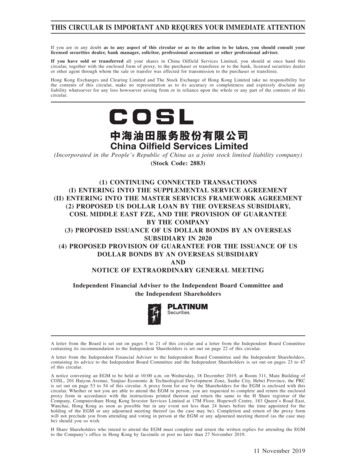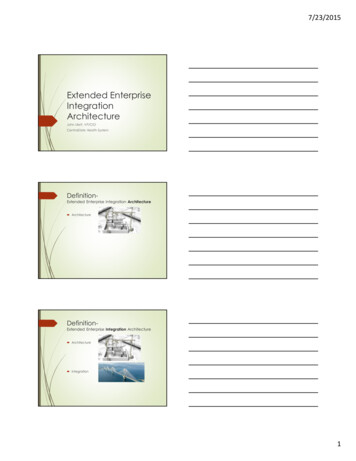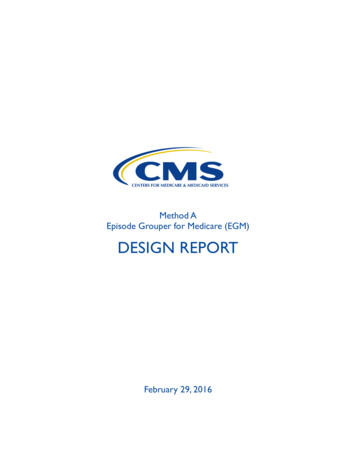
Transcription
Method AEpisode Grouper for Medicare (EGM)DESIGN REPORTFebruary 29, 2016
Episode Grouper for Medicare (EGM) Design ReportTABLE OF CONTENTSExecutive Summary . v1. Introduction . 12. Episode Definitions and Specifications . 12.1Defining Condition Episodes . 22.1.1 Conditions . 32.1.2 Condition Episodes for Reporting and Analysis . 32.1.3 Limited Episodes. 42.2 Defining Treatment Episodes . 52.2.1 Selecting Treatment Episodes . 52.2.2 Development of Treatment Episodes from Service Concepts . 72.3 Relevancy . 83. Building Episodes: A Summary of the Process . 114. Episode Shells.144.14.2Episode Identification . 15Closing Rules. 184.34.4Combining Condition Episode Shells. 19Acute and Chronic Episodes for the Same Condition. 214.5Combining Treatment Episode Shells . 224.6Stratification of Episodes . 245. Assignment of Services to Episodes . 255.15.2Overview of the Logical Steps in Assignment. 26Service Pairs and Interventions . 285.3 Direct Assignment of Interventions by Type of Service . 305.3.1 Acute Hospital Inpatient Services . 315.3.2 Assignment of Evaluation and Management (E&M) Services . 325.3.3 Assignment of Outpatient Department and Other Services . 335.3.4 Assignment of Home Health or Skilled Nursing Facility Services . 335.45.5Alternatives for Acute and Post-acute Services. 33Look-Back Periods . 335.6Allocating Service Costs to Episodes . 346. Associations among Episodes . 366.16.2Episodes and Their Sequelae . 37Treatment Episodes and Their Indications . 386.3Acute and Chronic Condition Episodes for the Same Illness . 39iii
Episode Grouper for Medicare (EGM) Design Report7. Determining Expected Costs . 407.1Risk Adjustment . 407.1.17.1.2Time Periods for Estimation . 41Risk Factors . 41Appendix A. Glossary .A-1Appendix B. Design Report Technical Notes/Reports . B-1FIGURESFigure ES-1: Overview of How EGM Constructs Episodes. viiFigure 1: Example Treatment Episode. 5Figure 2: Example Services . 8Figure 3: Example Sequela . 9Figure 4: Episode Construction Process . 11Figure 5: Trigger Rules and Episode Shells . 15Figure 6: Combining Condition Episode Shells. 20Figure 7: Combining Treatment Episode Shells . 23Figure 8: Assignment of Services to Episodes . 27Figure 9: Look-Back Periods . 34Figure 10: Allocating Service Costs to Episodes . 35Figure 11: Example of Risk-Adjusting Heart Failure Using Patient’s Episode Profile . 43Figure 12: Accounting Periods Selected from a Patient’s Episode Experiences.B-2Figure 13: Example of Risk-Adjusting Heart Failure Using Patient’s Episode Profile .B-6TABLESTable 1: Trigger Rules for Identifying Condition Episodes . 16Table 2: Service Pair Table. 29Table 3: Hierarchy of Rules for Service Assignment . 30iv
Episode Grouper for Medicare (EGM) Design ReportEXECUTIVE SUMMARYMedicare and other third-party payers maintain very detailed records of reimbursements for individualhealthcare services. In addition to supporting provider payment, these records represent a wealth ofinformation about patterns of care and information about opportunities for improvement. The conceptualframework presented here involves using an episode grouper (or “grouper”) to organize administrative claimsdata into episodes-of-care, or simply episodes, which are sets of services provided to care for an illness orinjury during a defined period of time. The National Quality Forum endorsed this approach in its consensusreport on a measurement framework for evaluating efficiency, 1 and wrote the following in its more recentreport on evaluation of episode groupers:In recent years, there has been a drive toward performance measurement based on the patient’sepisode of care in how to better understand the utilization and costs associated with certainconditions. Measurement based on an episode of care facilitates this by attributing care tocondition-specific or procedure-specific episodes based on the relationship of the healthcare service tothe care of a specific condition (i.e., all diabetes-related care is attributed to the diabetes episode ofcare) Episode grouper software tools are a generally accepted method for aggregating claims data intoepisodes to assess condition-specific utilization and costs. Using an episode grouper, healthcareservices provided over a defined period of time can be analyzed and grouped by specific clinicalconditions to generate an overall picture of the services used to manage that condition. 2CMS has developed a software application—the Episode Grouper for Medicare (EGM)—for organizingadministrative claims into information about resource use that can be used to support various programobjectives.This Design Report describes the tool with respect to its development and logical components. Potential usescould include accountability, where cost outcomes could be linked to other performance domains; andperformance improvement, where cost and utilization patterns could identify opportunities to coordinatecare, and provide more efficient healthcare for individuals or populations.i.What is the Episode Grouper for Medicare (EGM)?EGM is a software application that reads Medicare administrative claims data chronologically by beneficiary,and assigns services and their associated Medicare payments to episodes of care. Episodes correspond toclinically meaningful topics such as a clinical condition defined by diagnosis codes (e.g., pneumonia), or inother cases, a particular type of treatment defined by procedure codes (e.g., pacemaker insertion).12National Quality Forum (NQF). Measurement Framework: Evaluating Efficiency Across Patient-Focused Episodes of Care.Washington, DC: NQF; 2009National Quality Forum (NQF). Evaluating Episode Groupers: A Report from the National Quality Forum. Washington, DC:NQF; 2014v
Episode Grouper for Medicare (EGM) Design ReportOne of the most basic objectives of EGM is to describe or account for Medicare cost and utilization usingcategories that make sense to clinicians and others who are responsible for patient care and healthcaresystems. For example, how much does diabetes or ischemic heart disease cost Medicare in terms of routinecare, acute exacerbations, and sequelae that emerge over time? What settings or types of providers areinvolved in the care of patients simultaneously or sequentially?EGM standardizes and automates the construction of resource use measures. Clinically meaningful episodesprovide the context from which to interpret the relevance of various services provided to patients over time.The goal is to be inclusive with respect to the services and costs that result from an episode including claimsfor non-specific diagnoses such as signs and symptoms (relevant diagnoses); plausible procedure/servicecodes (relevant services); and aftereffects and secondary results of care (i.e., sequelae).ii.Why build episodes?Another objective of EGM is to estimate average Medicare payments for episodes, risk-adjusted according topatient-level information and other factors as appropriate. These risk-adjusted costs can serve as referencepoints for comparison; for example, to know the extent to which actual episode costs for specific patientcohorts (e.g., defined geographically or by attribution to providers) may deviate from the average cost forclinically similar patients.Another objective is to frame spending patterns in ways that highlight opportunities for improvement. Someopportunities may reside within a physician practice (e.g., low-value or duplicative services), while othersmight be “downstream” consequences such as sequelae (e.g., hospital admissions for sepsis followingsurgery), or problems “upstream” (e.g., missed opportunities to avoid acute exacerbations, or reduce the needfor surgery). Layers of information can be produced for different aspects of decision-making, includingindividual practitioners or facilities, and the continuum of care in delivery systems or whole market areas.iii.How does EGM incorporate clinical expertise?Clinicians interpret patient information based on known relationships and probabilities. For example,clinicians understand that cough can be a symptom of pneumonia, sepsis is a possible sequela of pneumonia,and a case of pneumonia rarely lasts more than a week or so. Each condition has its own time course and setof possible symptoms and sequelae with implicit time-dependent probabilities for each relationship.Clinicians also know which tests and treatments are used and likely effective for different conditions. EGMemulates this set of relationships and probabilities using administrative claims data.EGM has been developed with input from physicians and other clinicians, including individuals at CMS andthe Agency for Healthcare Research and Quality, support contractors, and other experts recruited throughbroad invitations.3 This led to the development of detailed clinical information, or specifications for eachepisode, which are stored in tables that are accessed by the EGM software as it processes information onclaims data. (Section 2 of this document discusses how episode specifications are derived.) Those tables are3The project team solicited advisors through a number of channels; for example, see: American Medical Association. Call forNominations to Participate in the CMS Episode Grouper Project. Physician Consortium for Performance ImprovementNewsletter. June 11, 2013.vi
Episode Grouper for Medicare (EGM) Design Reportcalled the Episode Definition Data (EDD) and include clinical facts, such as possible symptoms, tests,treatments, and sequelae for each type of episode.EGM software uses those tables along with patient-specific claims data, including date and place of service,type of provider, diagnosis, and procedure/service codes to construct episodes, and in effect, assemble anautomated history for each patient. Just as an encrypted message may seem meaningless, raw claims datamight also seem, at first glance, to be a jumble of information. But, the actions of clinicians are purposeful,and a patient’s claims can be deciphered into a meaningful history using clinical intelligence in the EDD asthe key to unlock the code.iv.How does EGM construct episodes?EGM functions through interactions between the rules encoded in the software application and the clinicalknowledge stored in the EDD tables. Figure ES-1 provides an overview of how EGM constructs episodes.Figure ES-1: Overview of How EGM Constructs EpisodesClaims. EGM processes Medicare Part A and Part B claims data that are arranged in chronological order bybeneficiary. The software first links pairs of service elements that are disjointed in Medicare Fee for Servicebills, such as producing an image study along with the clinician’s reading and reporting on the study, intomore clinically-meaningful services (e.g. an imaging test). The result of this linking is a database of servicesready for episode identification.Episode Identification. EGM reads the resulting set of services in chronological order to determine when apatient is involved in an episode of any given type. For example, a hospital admission for heart failure couldtrigger an episode of acute heart failure.Assignment. EGM reads the service data again to determine which services provided to the patient arerelevant to each open episode. For example, an Electrocardiogram is relevant to an open episode for acutemyocardial infarction (AMI).Association. EGM determines the clinical relevance among episodes, such as an acute condition episode thatalso is an acute exacerbation of an underlying chronic condition episode, or is a sequela to a specificcondition or treatment episode. For example, acute heart failure immediately following treatment for AMI ora major surgery could be deemed a sequela of those antecedent episodes.vii
Episode Grouper for Medicare (EGM) Design ReportRisk Adjustment. EGM determines drivers of episode costs such as case-mix, severity, and recent clinicalevents, and adjusts cost estimates for these factors in order to improve the validity of comparisons acrossgroups of patients with clinically similar episodes.Output. The last segment of Figure ES-1 shows that EGM produces output data sets consisting of theepisodes of care applicable to each patient. These include episodes defined by diagnoses, called conditionepisodes, and episodes defined by procedures, which are called treatment episodes. In other words, conditionepisodes are defined in terms of what diagnosis the patient has, whereas treatment episodes are defined interms of what the physician does.Subsequent sections of this executive summary consider each of the major steps in more detail.v.How is an episode triggered?EGM examines claims data in chronological order by patient and compares the information to specifiedcriteria needed to trigger any given episode. Episodes are triggered by a combination of trigger rules (i.e., thenature of the evidence in claims required to trigger an episode) and trigger codes (i.e., the particular codes onclaims that identify a particular type of episode). To trigger an episode for acute myocardial infarction (AMI),for example, there must be one of the specified diagnosis trigger codes for that condition (e.g., AMI ofanterolateral wall, initial episode of care) conforming to the trigger rule for that condition (i.e., trigger code inprincipal position on an inpatient facility claim). For each episode there is a corresponding set of triggercodes and one or more trigger rules.Trigger codes are used in conjunction with trigger rules to identify each instance of an episode. EGMsupports a number of rules that reflect information available from different types of providers (e.g., hospitalversus physician claims) and how that information can be used to trigger an episode. A trigger code for aparticular condition may have to be observed only once on an inpatient claim, or more than once onoutpatient claims. Similarly a trigger code for a treatment episode may have to be observed on a facility claim,a professional claim, or both. For example, a principal diagnosis of heart failure on a hospital claim cantrigger acute (and chronic) heart failure episodes, whereas more than one professional evaluation andmanagement services in the outpatient setting for heart failure can trigger a chronic heart failure episode.Section 4.1 describes the identification of episodes from claims data.Triggering a chronic condition episode is not necessarily the same thing as identifying when the patient’sillness began, or even when it became diagnosed for the first time. However, it is important to use theinformation when it becomes available, including the presence of an episode of care for the chroniccondition. This allows EGM to track services and costs related to that condition, and use information aboutthe presence of the condition to set cost expectations related to that condition as well as likely otherconditions that may be caused or exacerbated by the underlying condition.vi.How is an episode closed?Episode specifications indicate when an episode will close. EGM is optimized currently for episodes to closeafter a predetermined fixed-length interval. Episodes defined by acute conditions typically close 90 days afterthe date on which they were triggered. Similarly, treatment episodes defined by a specific procedure will closeviii
Episode Grouper for Medicare (EGM) Design Report90 days after the trigger date. Episodes defined by chronic conditions may last for as long as the patient iscovered by Original Medicare. For any given type of episode, exceptions to the default rules are specified inthe EDD.A second approach also is available by which the duration of an episode can be determined by servicepatterns instead of a fixed length. Using this approach, an episode will close after a predetermined timeinterval in which the patient does not receive services indicating continued care for that episode. Thisvariable-length approach to closing episodes can support analyses of variability in service utilization patterns.For example, treatment for clinical depression may be brief or more prolonged. Section 4.2 describes closingrules for episodes.vii. Can more than one episode be open at the same time?Under most circumstances a patient can have more than one episode at a time representing differentconditions or treatments. For example, a patient can have multiple concurrent chronic condition episodesopen, perhaps overlapping in time with acute condition episodes or treatment episodes of various types.EGM permits such overlapping or concurrent episodes, even while recognizing that clinical treatmentpatterns and resource use can be affected by interactions between conditions, and between conditions andtreatments. For example, the occurrence of pneumonia can influence clinical management and resource usefor concurrent conditions such as Chronic Obstructive Pulmonary Disease (COPD) or heart failure. Section4.3 describes how EGM combines condition episodes that cannot co-exist; Section 4.5 discusses overlappingtreatment episodes.Exceptions exist to the general rule that multiple episodes can be open at the same time. One suchcircumstance relates to observing in the claims data what could appear to be more than one conditionepisode (sufficient to trigger each one, respectively), but more likely represents uncertainty among providersabout what is the patient’s true underlying condition. EGM applies rules that also clarify which episodes tobuild, and which episode(s) to merge, subsume, and otherwise essentially discard.4 For example, an episode ofcommunity-acquired pneumonia may be triggered by outpatient evaluation and management (E&M) serviceswith corresponding trigger codes; but followed shortly by a hospital admission for aspiration pneumonia.Given such a pair of episodes triggered closely in time, EGM would interpret the aspiration pneumonia asprimary and would merge with the community-acquired pneumonia episode. Services and costs that wouldhave been assigned to community-acquired pneumonia would instead be assigned to aspiration pneumonia,and the community-acquired pneumonia episode is discarded.viii. How are services assigned to an episode?A major aspect of building an episode is determining which services that a patient receives ought to beassigned to that episode. EGM does not build one episode at a time. Rather, EGM builds multiple episodessimultaneously by passing through the claims data to assign each service to one episode that is open on the4Merging can occur when two episodes appear to begin around the same time, but only one of the pair will be considered an openepisode. Subsuming can occur when one episode is already open, another episode appears to begin, and EGM determines whichepisode in the pair is open thereafter.ix
Episode Grouper for Medicare (EGM) Design Reportdate of the service, to more than one episode, or to no defined episode at all (e.g., a single service for a nonspecific diagnosis that is not relevant to any open episode).EGM uses a hierarchical set of rules for service assignment that allow the best evidence available todetermine the assignment. The rules are summarized in the next several sections. The governing principle isthat a service should be assigned to the episode(s) for which it is most relevant, taking into account procedurecodes, diagnosis codes, and timing. Generally, codes that identify an episode (i.e., trigger codes) are highlyrelevant and likely to be assigned to the episode. Commonly used services with potential clinical benefit, orcommonly observed or treated symptoms also can be assigned to an episode. Assignment can be affected bytiming as well. For example, an ambulance service may be assigned to the same episode as the emergencydepartment or dialysis center claim that follows. Section 5 describes the service assignment rules, andcircumstances that can affect assignment.ix.What are an episode’s relevant services?Each episode specification has a set of procedure codes, called relevant services. Relevant services are thoseservices that are considered to have a plausible clinical purpose related to that episode. A nebulizer, forexample, is a relevant service for asthma but not for osteoarthritis. A patient may receive a nebulizer whileepisodes for asthma and osteoarthritis are both open. If the claim including the nebulizer was included on anoutpatient department claim (which allows multiple diagnoses but does not align specific diagnosis codes withspecific procedure codes), the EGM would determine that the nebulizer is a relevant service for asthma butnot for osteoarthritis and therefore the service is likely to be assigned only to asthma.However, it is common for beneficiaries to have many episodes open when a given service is provided, andthat service may be relevant to more than one episode. Furthermore, the mere fact that a procedure code islisted as relevant to an episode does not mean that the service automatically will be assigned to that episode.For example, a certain type of lab test may be relevant to any of several open episodes, but the diagnosiscode on the claim may indicate a specific episode.The list of relevant services for each type of episode was developed using a two-stage process. First, arepresentative Medicare claims database was examined for services that included one or more trigger codesfor the episode of interest. The procedure codes from those claims were used to produce a candidate list ofrelevant services, i.e., procedure codes that might be clinically relevant to that episode. Such a culling alsocould include other procedure codes that co-occurred with the trigger codes, but for reasons other thanplausible clinical relevance to the type of episode defined by those trigger codes. The candidate list was thenlimited to the services that contributed most to the costs attributed to that type of episode.Second, clinicians reviewed the candidate list, and removed all service codes for which clinical relevance tothat episode was not clinically plausible under virtually any conceivable scenario. Note, the criteria appliedhere were looser than strict clinical appropriateness; rather, the attempt was to capture the most impactfulprocedures that were provided to beneficiaries in relation to that type of episode.x
Episode Grouper for Medicare (EGM) Design Reportx.What are an episode’s relevant diagnoses?Each episode has a set of diagnosis codes, called relevant diagnoses, which are considered to be plausiblefindings, symptoms, and various presentations that often occur in relation to a given episode. Suppose apatient has episodes open for hypertension and pneumonia, and has an E&M office visit or an emergencydepartment visit with a diagnosis code indicating treatment for cough symptoms. Following from the clinicalfact that cough could arise from pneumonia but not hypertension, the service would be assigned only to thepneumonia episode and not the hypertension episode. Including diagnoses relevant for each episode helps tocapture the range of services and costs that are related to an episode even when more specific diagnoses arenot included on the claim.The list of relevant diagnoses for each episode was developed following a two-stage process similar to theone used for relevant services. First, a representative Medicare claims database was examined for all diagnosiscodes that appeared on service claims during the same time intervals as service claims with trigger codes forthat type of episode. In other words, during the time in which an episode would be open based on thepattern of trigger codes, what other services occurred with what diagnosis codes? A threshold of statisticallikelihood or association was applied. To be considered further, the diagnosis codes must occur significantlymore often when the episode is open than when it is not. This produced a candidate list of relevant diagnosesthat might be clinically relevant to that episode, but still could include oth
more clinically-meaningful services (e.g. an imaging test). The result of this linking is a database of services ready for episode identification. Episode Identification. EGM reads the resulting . set of services in chronological order to determine when a patient is involved in an episode of any given type.



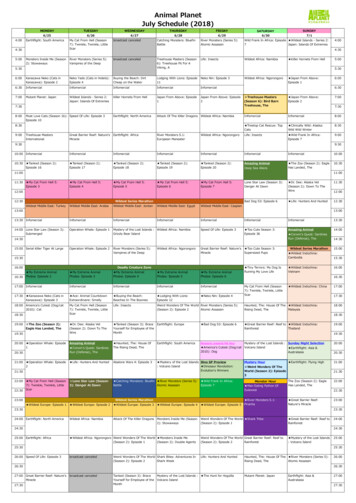
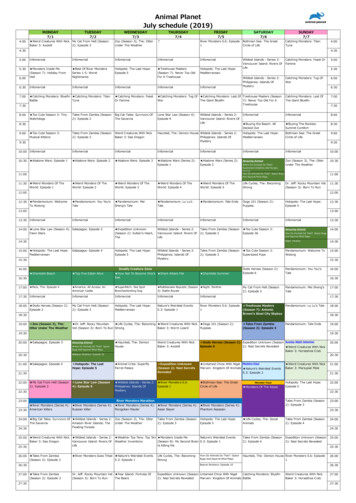


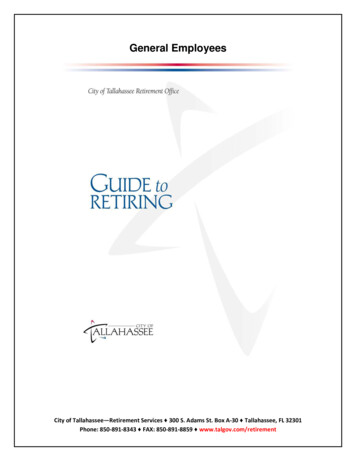
![Expanding Grain Model [EGM v1.0][EGM v1.0]](/img/25/egm-user-manual.jpg)
